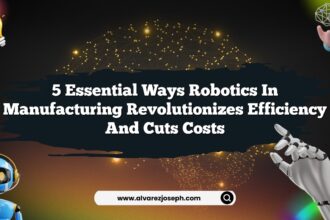Imagine a factory where robots work side by side with humans, not just as machines, but as intelligent partners. This futuristic scene isn’t as far-fetched as it may sound. In fact, artificial intelligence (AI) is already reshaping the landscape of industries, particularly in robotics, leading us toward a smarter and more efficient future. The question is, how exactly is AI in robotics transforming industries? Buckle up, because we’re about to dive deep into the seven essential ways this technology is changing the game.
AI and Robotics: A Match Made in Tech Heaven
Before we jump into the nitty-gritty, let’s set the stage. Robotics powered by AI is not just about creating machines that can lift heavy objects or perform repetitive tasks. It’s about building systems that can learn, adapt, and even think—at least in a way. With machine learning algorithms, robots can analyze data from their environment and make decisions in real-time. This collaboration between AI and robotics opens doors to unprecedented levels of efficiency and innovation across various sectors.
But hold on! What does this mean for industries like manufacturing, healthcare, and logistics? Let’s break it down.
1. Revolutionizing Manufacturing with Smart Robots
When you think of manufacturing, you might picture assembly lines and conveyor belts. However, today’s factories are becoming more sophisticated, thanks to AI-driven robots. These machines can now analyze production data to optimize workflows, identify bottlenecks, and predict maintenance needs.
The Benefits of Smart Manufacturing
- Increased Efficiency: Robots can work around the clock without taking breaks, leading to higher productivity.
- Quality Control: AI algorithms can inspect products more accurately than the human eye, reducing defects.
- Flexibility: Smart robots can be reprogrammed to handle different tasks, adapting to changing production needs.
This shift towards smart manufacturing isn’t just a trend; it’s a necessity for companies striving to remain competitive in an ever-evolving market. But wait, there’s more!
2. Enhancing Healthcare with Robotic Assistants
Picture a world where surgical robots assist doctors in performing complex procedures with pinpoint accuracy. AI in healthcare robotics is making this a reality. These robots are equipped with advanced sensors and machine learning capabilities to support healthcare professionals in various ways.
How Robotics is Transforming Healthcare
- Precision Surgery: Robots can perform minimally invasive surgeries, reducing recovery times and improving patient outcomes.
- Patient Monitoring: AI-driven robots can track vital signs and alert healthcare providers in case of emergencies.
- Elderly Care: Robotics can assist with daily activities and provide companionship, addressing the growing demand for elderly care.
Imagine being a patient knowing that a robot is capable of performing your surgery with extreme precision. It’s a comforting thought, isn’t it? However, it also raises questions about the future of the medical profession—how do humans and robots coexist in such a critical field?
3. Optimizing Logistics with Autonomous Vehicles
Let’s hit the brakes for a moment and consider logistics. With the rise of e-commerce, the demand for efficient delivery systems has skyrocketed. Enter AI-powered autonomous vehicles. These self-driving robots are equipped with sophisticated navigation and decision-making systems, allowing them to transport goods more efficiently.
Advantages of Autonomous Logistics
- Reduced Costs: By minimizing the need for human drivers, companies can cut down on labor costs.
- Faster Deliveries: Autonomous vehicles can optimize routes in real-time, ensuring timely deliveries.
- Safety Improvements: With AI monitoring road conditions, the likelihood of accidents can be significantly reduced.
The logistics industry is witnessing a transformation that could change how products reach consumers forever. But what does this mean for jobs in the transport sector? That’s a cliffhanger worth pondering.
4. Crafting Better Customer Experiences in Retail
Imagine walking into a store where a friendly robot greets you and offers personalized shopping recommendations. AI-powered robots are becoming integral to the retail experience, enhancing customer service and operational efficiency.
How Retail is Evolving with Robotics
- Personalized Assistance: Robots can analyze customer preferences and suggest products tailored to their needs.
- Inventory Management: AI robots can monitor stock levels and automatically reorder items, reducing the risk of shortages.
- Enhanced In-Store Experience: Robots can guide customers through stores, providing information and support, creating a seamless shopping experience.
As retail embraces these technological advancements, the question arises: Can robots truly understand human emotions and preferences? It’s a tricky balance between technology and the human touch.
5. Transforming Agriculture with Precision Farming
Let’s take a stroll through a farm—yes, even farms can benefit from AI and robotics! Precision farming employs robotics to analyze crop health, optimize resource use, and increase yield.
Benefits of Robotics in Agriculture
- Crop Monitoring: Drones equipped with AI can survey fields and assess crop health, detecting issues before they become severe.
- Automated Harvesting: Robots can harvest crops more efficiently, reducing labor costs and food waste.
- Resource Optimization: AI can analyze weather patterns and soil conditions to advise farmers on the best planting times and resource allocation.
The future of farming looks promising, but it also raises questions about sustainability and how technology impacts traditional farming practices.
6. Driving Innovation in Construction
In the construction sector, robots equipped with AI are revolutionizing the way buildings are designed and constructed. Imagine a site where drones survey the area, robots lay bricks, and AI systems manage the entire project efficiently.
The Impact of Robotics on Construction
- Increased Safety: Robots can perform dangerous tasks, reducing the likelihood of accidents on construction sites.
- Cost Efficiency: By automating repetitive tasks, projects can be completed faster and within budget.
- Design Innovation: AI can assist architects in creating designs that are not only visually appealing but also structurally sound.
As construction continues to evolve, we can’t help but wonder if robots will one day replace human builders entirely. It’s a thought that sends shivers down the spine, doesn’t it?
7. Pioneering Space Exploration with Autonomous Robots
Last but not least, let’s venture into the cosmos. Robotics in space exploration is a fascinating frontier. With AI, robots are capable of exploring distant planets, analyzing data, and even performing repairs on spacecraft—all without a human being in sight!
The Role of Robotics in Space
- Data Collection: Robots can gather samples and data from environments that are inhospitable to humans.
- Remote Operations: AI-driven robots can conduct repairs and maintenance on spacecraft while astronauts focus on other tasks.
- Pioneering New Worlds: As we dream of colonizing other planets, autonomous robots will play a crucial role in scouting and preparing these new frontiers.
The possibilities in space are limitless. But just imagine, what if we find extraterrestrial life? How would robots handle such a monumental moment?
Quick Summary
- AI in robotics is revolutionizing manufacturing with smart systems that optimize production.
- Healthcare is seeing surgical robots that enhance precision and improve patient care.
- Logistics are transforming with autonomous vehicles that lower costs and improve delivery efficiency.
- Retail experiences are becoming interactive with personalized robot assistants.
- Agriculture is benefiting from precision farming, enhancing crop management and yield.
- The construction industry is leveraging robots for safety and efficiency.
- Space exploration is advancing with autonomous robots that gather data and conduct repairs.
Frequently Asked Questions
What is the role of AI in robotics?
AI enhances robotics by enabling machines to learn from data, adapt to various tasks, and make informed decisions, leading to increased efficiency and productivity.
How is AI changing the manufacturing industry?
AI allows for smart manufacturing processes that optimize production, improve quality control, and enhance flexibility in operations, making factories more competitive.
Are robots replacing human jobs?
While robots are automating certain tasks, they also create new job opportunities in technology development, maintenance, and oversight. The future job landscape will likely require a shift in skills.
What are the benefits of AI-powered robots in healthcare?
AI-powered robots can perform surgeries with greater precision, assist in patient monitoring, and provide support for elderly care, improving overall healthcare outcomes.
How are autonomous vehicles impacting logistics?
Autonomous vehicles reduce labor costs, speed up delivery times, and enhance safety by using AI to monitor and navigate road conditions effectively.
What does the future hold for AI and robotics?
The future promises even more integration of AI in various industries, leading to smarter, safer, and more efficient systems that could change how we live, work, and explore the universe.
It all comes down to how we choose to embrace this technological revolution. So, what does it mean for you? The journey of AI and robotics is just beginning, and it could depend on what you are looking for.












